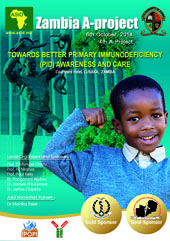Reem Elfeky1,2
1-Lecturer of Paediatrics, Ain Shams University, Cairo Egypt.
2-Fellow in Paediatric Immunology/Allergy, the Great North Children’s Hospital, the UK
Genetic defects cause primary immune deficiency (PID), which predispose to infections.
Seventeen patients from 7 unrelated families have been evaluated for a common clinical presentation with an autosomal dominant pattern of inheritance, recurrent respiratory infections, airway damage, viral infections and malignancy (table 1). Laboratory investigations revealed lymphopenia with low class switched memory B cells, high IgM, low IgG2, with poor vaccine responses. Genetic analysis identified a mutation in their PIK3 CD gene resulting in an overactive protein called PI3K-p110 delta (1).
PI3K proteins are essential for production of phosphoinositides which act as second messengers for intracellular signaling in several processes directing the growth and activity of many types of immune cells. PI3K-p110 delta is specifically involved in B and T cells (figures1-3) (1-3).
The genetic information allowed the researchers to identify and target mTOR, an important signal that is excessively activated by PI3K-p110 delta in APDS patients. One patient was treated with Rapamycin ; mTOR inhibitor which restored T cells to normal levels in 4 months. While the disease was not cured, normalization of T cells was adequate to improve disease symptoms (4).
Though rapamycin is currently used to manage cases with APDS, the only curative treatment is stem cell transplantation; which seems crucial to manage infections and prevent evolving malignant transformation.
Summary of clinical and immunological features of patients with the p110δ mutation
|
Clinical / Immunological manifestation |
Patients |
Number/percentage |
|
Recurrent respiratory and ear infections (H. influenzae, S. pneumoniae) |
P1-17 |
17/17 (100) |
|
CT evidence of large (bronchiectasis) or small (mosaic attenuation) airway disease |
P1-7,9,11-13,17 |
12/16 (75) |
|
Splenomegaly (prior to the onset of recurrent infections) |
P2,3,5,6,8,9,13-16 |
10/17 (59) |
|
Skin, salivary gland, lacrimal gland or dental abscess formation, orbital cellulitis |
P1,3,5-8,10 |
7/17 (41) |
|
Infection caused by herpes group viruses (HSV, CMV, VZV, EBV) |
P3,8,12,13 (and the deceased |
4/17 (24) |
|
Marginal zone lymphoma |
P13 |
1/17 (6) |
|
Low/intermittent low serum IgG2 levels |
P2-7,10-13 |
10/11 (91) |
|
High/intermittent high serum IgM levels |
P1-6,8-11,13-16 |
14/17 (82) |
|
Low levels of anti-pneumococcal antibodies |
P1-4,7,9,11-13,17 |
10/10 (100) |
|
Low levels of anti-Haemophilus Influenzae type B antibodies |
P1-4,8,9,12,13 |
8/10 (80) |
|
Decreased circulating T cells (total CD3+) and/or CD4+ and/or CD8+ T cells |
P1-9,13,14,17 |
12/17 (71) |
|
Decreased circulating B cells (total CD19+) |
P2-9,13,14-16 |
12/17 (71) |
|
Increased circulating transitional B cells (CD19+CD38+IgM+) |
P1-4,7-14,16,17 |
14/16 (88) |
|
Decreased circulating class switched memory B cells (CD19+CD27+IgD−) |
P1-3,8,9,12,13,16 |
8/16 (50) |
Quoted from Angulo et al; 2013



Reference:
1- Angulo I, Vadas O, Garçon F, Banham-Hall E, Plagnol V, Leahy TR, Baxendale H, Coulter T, Curtis J, Wu C, Blake-Palmer K, Perisic O, Smyth D, Maes M,Fiddler C, Juss J, Cilliers D, Markelj G, Chandra A, Farmer G, Kielkowska A, Clark J, Kracker S, Debré M, Picard C, Pellier I, Jabado N, Morris JA, Barcenas-Morales G, Fischer A, Stephens L, Hawkins P, Barrett JC, Abinun M, Clatworthy M, Durandy A, Doffinger R, Chilvers ER, Cant AJ, Kumararatne D, Okkenhaug K,Williams RL, Condliffe A, Nejentsev S. Phosphoinositide 3-kinase δ gene mutation predisposes to respiratory infection and airway damage. Science.2013, 15;342(6160):866-71.
2- Koyasu S. The role of PI3K in immune cells. Nature immunology.2003, 4(4):313-318.
3- Lucas CL, Kuehn HS, Zhao F, Niemela JE, Deenick EK, Palendira U, Avery DT, Moens L, Cannons JL, Biancalana M, Stoddard J, Ouyang W, Frucht DL, Rao VK, Atkinson TP, Agharahimi A, Hussey AA, Folio LR, Olivier KN, Fleisher TA, Pittaluga S, Holland SM, Cohen JI, Oliviera JB, Tangye SG, Schwartzberg PL, Lenardo MJ, and Uzel G. Dominant-activating germ line mutations in the gene encoding the PI3K subunit p110d result in T cell senescence and human immunodeficiency. Nat Immunol. 2014 Jan;15(1):88-97.
4- Tzenaki N, Papakonstanti EA. p110δ PI3 kinase pathway: emerging roles in cancer. Front. Oncol. 2013; 4:1-18.



























